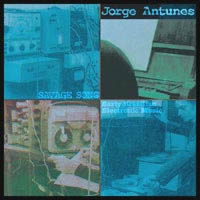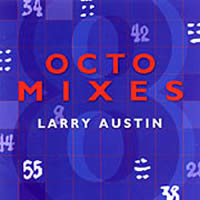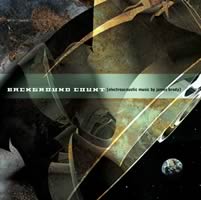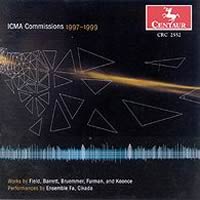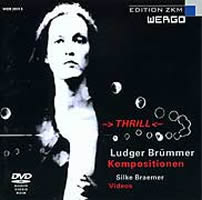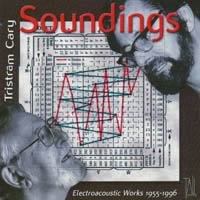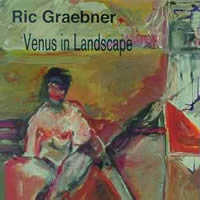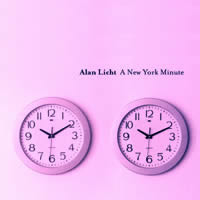Dipping into the “EA” Bucket 1.
|
Grant Chu Covell [February 2004.]
On September 24, 1961, David Tudor and others gave the first electroacoustic music concert in Rio de Janeiro, Brazil, programming Stockhausen’s Kontakte alongside works by Pousseur, G.M. Koenig, Earle Brown and Bussotti. Jorge Antunes was in the audience. Trained as a radio engineer, the 19-year-old had to try his hand at the new medium. Pogus P21027-2 (http://www.pogus.com/) collects 14 sizzling tracks Brazil’s first electroacoustic composer created between that pivotal year and 1970. Precocious Antunes possessed several traits of a successful composer: a good ear, persistence, and the desire to innovate. Self-taught, he created tape loops, scratched LPs to isolate single grooves, and employed a tape recorder for primitive multi-tracking. His first studio was actually his parents’ home, filled with his father’s clocks. His mother and sister helped him halt and restart the collection so he could record in silence. The young Brazilian built his own electronic equipment. Hear his sawtooth wave generator in the blunt, Varèse-like Pequena Peça para Mi bequadro e Harmônicos (Short Piece for E natural and Harmonics) of 1961 and the elegant 1962 Valsa Sideral (Sidereal Waltz), which today sounds like wooing car alarms. Ghostly reverb blurs hypnotic ostinatos folded with sine wave improvisations in the 1964 Fluxo Luminoso para Sons Brancos I (Luminous Flow for White Sounds I) and Contrapunctus contra Contrapunctus (1965). Antunes is also at home with acoustic sounds, such as the intermittent tapping that invigorates the arrhythmic 1967 Canto Selvagem (Savage Song). Several works were created in Argentina after political pressures in Brazil made Antunes’ artistic life impossible there. Auto-Retrato sobre Paisaje Porteña (1969/70) commences with a stately fusion of tango and samba derived from a wind-up gramophone record. Along the way the composer’s garbled speech — doubly obscure because Portuguese is so unfamiliar — hints at the Latin American political landscape. Both music and voice grow irrevocably distorted. The four-part Historia de un Pueblo por Nacer or Carta Abierta a Vassili Vasilikos y a todos los Pesimistas (1970) soberly continues the self-portrait’s vein. These raw pieces surpass the constraints of their creation. Today’s electroacoustic practitioners can learn from Antunes: Work economically, respect your materials, and hang in there.
Solo tape works and pieces for live instruments with tape fill Mark Applebaum’s “Intellectual Property,” (Innova 602 [http://www.innova.mu/]). Mouseketier Praxis (2003) captures sounds generated from one of Applebaum’s sound sculptures, wacky assemblages of found objects and items trolled from hardware stores. Photos reveal twisted metal, nails, combs, springs, wheels, Astroturf, a mousetrap, a hotel bell, and a copper toilet-tank flotation ball (whose image is silkscreened on the CD). He electronically manipulates his creations’ noises into a private world suggesting life inside a pinball machine or one of Tudor’s Rainforest installations. Scipio Wakes Up (and Smells the Coffee) (1995) is an elaborate everything-but-the-kitchen-sink featuring live performers, electronics, and sound sculptures. Offering incisive playing, live amplified bassoon (Paul Hanson) and violin (Craig Fry) emerge from the Paul Dresher Ensemble. Intellectual Property I (2000) showcases Applebaum’s jazz abilities. The composer improvises with pre-recorded Disklavier. Two pieces are short teases. In the rambunctious Plundergraphic (2002), a “diffusion artist” combines tapes with live musicians playing a graphic score derived from other Applebaum compositions (hence the title). Ferneyhough Remix (Affection Aphorism I) (2003) samples percussionist Steven Schick’s recording of Ferneyhough’s Bone Alphabet and adds two live percussionists (Ivan Manzanilla and Schick again). Those who remain unimpressed by Applebaum’s instrument-making skills and technical abilities are bound to enjoy the closing tape piece, Pre-Composition (2002). Applebaum provides a front row seat onto an imaginary creative process. We hear a composer trying to create an eight-track tape objet with eight unruly voices competing for attention. A gleefully ambitious personality is obliged to work with a pragmatist. One voice is holistic, another snide. There’s even a referee. It’s cleverer than any description.
Four Larry Austin compositions occupy EMF CD 039 (http://www.emfmedia.org/). Two are portraits. Singing! the music of my own time (1996-98) effervescently sketches contemporary vocalist Thomas Buckner, familiar from his work on the Lovely Music label and elsewhere. Djuro’s Tree (1997) pictures three generations of Serbian mathematicians. Like a seasoned documentary filmmaker, Austin gently flavors his subjects’ voices with electronic processing and subtle sound effects. The delicate results are engrossing. Tárogató! (1998) mingles greatly manipulated pre-recorded Hungarian táragató (Esther Lamneck) with live saxophone improvs (Stephen Duke). Williams [re]Mix[ed] (1997-2001) is a grand homage to Cage’s 1951-53 Williams Mix. With Michael Thompson’s help, Austin converted Cage’s intricate instructions into a computer program. Feed it the six categories of sounds specified in the score and off it goes, apparently able to churn out countless “Son of Williams Mixes.” Austin isn’t after creating an automaton. He reveres Cage’s original, desiring to freshen it up for its 50th anniversary. His variants maintain the original’s humor and atmosphere. The disc is titled “Octo Mixes.” Originally meant to be played in an eight-speaker configuration, these pieces were converted to the home or headphone listener’s more typical two-speaker arrangement. Some sounds do swirl about like witches on broomsticks.
James Brody discovered Xenakis early. He was crucial in bringing the Greek exile to Indiana to teach between 1967 and 1972. Brody also wrote the liner notes for Nonesuch’s Xenakis LP (H-71246). Xenakis encouraged Brody to search for his own voice, though the master’s influence is evident. “Background Count,” a Furious Artisans release (FACD 6806 [http://www.furiousartisans.com/]), packages eight Brody electroacoustic works revealing a meticulous creator who delights in details. Brody generally works with tiny sound pieces, using sources from real life or studio creations. His music requires computer power for its realization; he’s been at technology’s forefront his entire career. Gentle noises whirr past in Entrainments (1995) and Turnings (1999). The fragile Background Count (1997) adds a live percussionist to processed sounds derived from a cosmic Geiger counter’s results. A Glance into the Garden (1998) pairs computer processing with flute. Barzakh (1983) is an eerie and unpretentious meditation on the passing of the composer’s father. I find a refreshing calmness in Brody’s music which frequently teems with complexity, but never violence nor anger. Occasionally familiar sounds peek through: an AM radio burst, bamboo wind chimes, or marbles rolling in a pan. Brody is a big proponent of granular synthesis, an electronic music technique closely linked with Xenakis in which microscopic sound bits are manipulated to create larger composite textures. Syllepsis, Hommage à Iannis Xenakis (2000) uses granular synthesis throughout its 15 minutes to create a subtly transient environment. You’ll want to measure out one piece at a time to savor their atmospheres.
Centaur’s “CDCM Computer Music Series” is a most venerable undertaking. Actually comprising four sub-series, the CDCM (Consortium to Distribute Computer Music) collection documents the genre’s vast range. Recent releases have plumbed the “Computer Music Studio” category. Such single-minded championing occasionally produces discs which suffer from a stifling sameness or provincial aesthetic. Volume 32 (Centaur CRC 2552 [http://www.centaurrecords.com/]; distributed by Qualiton [http://www.qualiton.com/]) contains five International Computer Music Association Commission Awards bestowed between 1997 and ’99. My initial trepidation melted away upon seeing the word “international” alongside familiar names. Ambrose Field’s Expanse Hotel (1999) is a silly little thing. Inspired by a retirement hotel populated with doddering actors, Field presents their dreams and nightmares. Two pieces match live instruments with electroacoustics. The Cikada Ensemble’s alto flute, percussion and double bass take part in Natasha Barrett’s Microclimate I: Snow and Instability (1998). Ensemble Fa’s larger group appears in Pablo Furman’s Concerto for Ensemble and Electronic Sounds (1997). Furman’s is the more typical of the two; Barrett achieves an opulent catalog of effects. I was very happy to hear Paul Koonce’s Breath and the Machine (1999). This piece continues the intricate cleverness of his mode CD (mode 90, see here). Koonce has honed in on the contradiction between a wind instrument’s mechanical parts and the human breath that brings them to life. A lugubrious opening flows gently into a macabre amusement-park adventure. Gently oscillating wind instruments are interrupted by rapid-fire mosaics in which dropping coins, a starting car, and toy piano lay buried. Koonce rarely permits blurriness, preferring crisp, almost naked sequences of sounds. I come back to this track repeatedly. Ludger Bruemmer claims that the melody in Lizard Point (1997) is derived from Ravel’s Gaspard de la nuit. Spread across many minutes, this atmospheric piece engrosses with kinetic washes that float past like metallic clouds. The music operates at entropy’s threshold. Sudden rampant outbursts force the listener into continual volume readjustment. It’s quite a ride. Lizard Point is joined with four other Bruemmer pieces on “THRILL,” a DVD playable in DVD audio and video players (Wergo WER 2059 5 [http://www.wergo.de/]; distributed in the US by Harmonia Mundi [http://www.harmoniamundi.com/]). I sampled it on two DVD readers which acceptably converted the sound into stereo audio. Bruemmer operates at a different pace. Phrenos (1977) and de la nuit’s (1990) transmogrifying textures are riveting. Inferno der Stille (2000) incorporates sly mutations of Mozart’s Requiem. Lizard Point is one of two compositions that accompany videos by Silke Braemer. Built from superimposed repetitions of dancers, running figures and bouncing lines, the video’s blockiness (production artifacts?) may not endure well. More artsy than fashionable, their collaborations aren’t really the sort of thing you plan to watch, rather they’re things you accidentally stumble upon. Breummer’s music is better suited for slowed-down helicopter excursions through the Grand Canyon or deep undersea exploration. (Centaur Americanizes Bruemmer’s name; German label Wergo uses the original Brümmer.)
Australian resident Tristram Cary has been at electroacoustic music’s front lines since its start. Trained in England as an electronics engineer, he became a radar officer during WWII, which is where he saw the tape recorder’s musical potential. His first 1947 electronic music studio used 78s. By 1952 he was working with tape. He’s written electronic and instrumental music, including the film score for The Ladykillers, starring Alec Guinness, and backgrounds for BBC programs, among them Doctor Who. With its great depth and exceptionally clear descriptions, his Illustrated Compendium of Musical Technology (Faber and Faber) is a frequently consulted reference. Distributed in the US by CDeMUSIC (http://www.cdemusic.org/), the Australian label Tall Poppies (http://www.tallpoppies.au.nu/) presents a densely packed two-CD retrospective of music Cary created in English and Australian studios (TP 139). The first disc contains analogue works from 1955-78. The genre’s classic blips and bleeps blend with studio-manipulated pianos and bells. These non-threatening analogue compositions are long, considering the mighty labors taken to create them. Included are several suites fashioned from BBC soundtracks: The Japanese Fishermen (1955), the first BBC production with an electronic score; The Children of Lir (1959), a King Lear variant; and Ray Bradbury’s radio play Leviathan ’99 (1972). 3 4 5 — A Study in limited resources for Stereo Tape is an outstanding 1967 composition built entirely from durations and frequencies that are multiples of 3, 4 or 5. The 1978 Steam Music was created from train sounds. Advancing into the computer age, the second disc demonstrates the same sure hand. Cary’s fascination with numbers persists in the Nonet, a sparkling 1979 composition whose nine voices explore an 18-notes-to-the-octave scale. Included in the booklet is a diagram showing the work’s structure. Cary makes it look so easy, almost inevitable that the fascinating music is the result of smart planning. Black, White and Rose (1991) is a substantial concerto for percussion (Ryszard Pusz) and tape. Among the other computer-created works are seven selections from The Impossible Piano (1994), inspired by Nancarrow’s player piano music.
Many electroacoustic compositions tend to be ugly. Countless works are oneiric, mining the unconscious by manipulating real sounds. Ric Graebner shies away from all that. His music concerns itself with pitches, themes and instrumental connotations, as if he sat down at a synthesizer to work everything out. It’s through-composed absolute electronic music. Originally meant to accompany slideshows or choreography, always-adventurous Metier (http://www.metierrecords.co.uk/) offers four Graebner pieces on MSV CD92019. Touching upon classical Roman and Greek imagery, they’re all around the same 1,000-second length. With its retro flavor, Venus in Landscape (1995) suggests a 1970s planetarium show. Graebner identifies a recurring lute theme. Carillon imitations and modal melodies also spin through the widely panned space. The composer describes the 1996 Fulminar, a psychedelic rondo as a “bright manic neurotic celebratory concoction of flavours.” A syrupy poem exploring the simultaneous religious and erotic power of statuary underpins Resurge (1997), whose pensive bittersweet mood suggests melancholy symphonist Allan Pettersson. The earliest work, Divertimento of the Statues (1993), aligns with conventional electroacoustic trends. Delicate color washes replace Fulminar’s continuously streaming bleeps. Infrequently appearing melodies contrast against the smoky texture. Spoken Greek electronically transformed adds mysterious ambiance. Ease of realization and vibrant sonorities were what attracted Graebner to the electroacoustic medium. He has become rather adept at producing works in a distinctive style. Standing apart from the crowd, he is not likely to father an electroacoustic revolution. However, he does provide a welcome respite from dominant trends.
I zone out whenever the weather forecast comes on. Something about saccharine phrases dressing up intrinsically lackluster and formulaic speculation puts me over the edge. Maybe I’m impatient for information that could easily be stated in a dozen words which is instead fluffed to fill several minutes. Alan Licht’s A New York Minute (2002) immortalizes a battalion of meteorologists sashaying though alternately confirming and contradicting assessments of New York City’s January 2001 climate. This clever assemblage alternates between intriguing and stultifying. Do you focus on the predictions and try to track their accuracy? Are you lulled by the announcers’ numbing cliché-laden delivery? Or does the background rat-a-tat-tat, the typewriter / ticker-tape sound suggesting a buzzing newsroom command your attention? The challenge is to remain alert. As with any good minimalist piece, the slowly evolving content forces us to downshift our antennae. The wintry predictions resolve to the noise of a subway station (the notes say Grand St.) with real voices and blipping automated ticket readers. Undoubtedly mystifying if you’ve never been in New York City during the winter, this work elegantly captures the moment. Frankly, it’s the sort of piece I wish I’d done myself. The aptly named Muhammed [sic] Ali and the Crickets (2001) blends ambient nature with chanting fans of the man who could “float like a butterfly and sting like a bee” (go see When We Were Kings, a documentary about the 1974 Ali-Foreman fight in Zaire). Freaky Friday (2003) and Another Sky (1997), assembled from guitars and organ sounds respectively, revel in straightforward multi-track minimalism. Guitarist Licht uses live electronics to enhance his instrument’s different timbres, including what sounds like knitting needles bouncing on the strings in 14, Second, Fifth (2000). With a record-breaking slow fade-in, Remington Khan (“Hearing Test” mix/12-string version) (2000) progresses gradually through various guitar stereotypes. Listeners already aware of Licht’s guitar chops will appreciate the taped live performances. A New York Minute, a piece with true staying power, names this six-piece collection on XI Records XI 128 (http://www.xirecords.org/).
[More EA Bucket, Grant Chu Covell]
[Previous Article:
Random Noise 6: Super OTW Lives!]
[Next Article:
The Nyman Bug]
|
